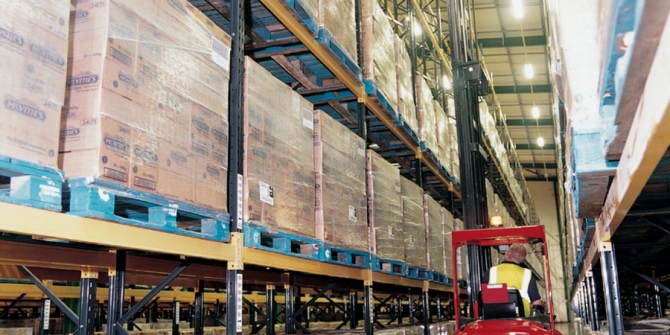Since they first appeared in the 1920s, lift trucks have become a ubiquitous sight in warehouses around the world. These vehicles are now essential to productivity, but they can also be extremely hazardous – causing around a fifth of the UK’s major workplace injuriesi and a quarter of all transport accidents.ii
Today, heavier loads combined with the ability to work at ever greater height increases the risk of serious injuries when accidents occur. Modern lift trucks can carry up to 50,000 kilosiii (the weight of the average Sperm whale) and reach more than 50 feet into the air.iv Working at height is undoubtedly the leading danger facing lift truck operators: half of accidents are caused by vehicles overturning while raising or lowering loads.v Even when these incidents don’t cause injuries, they can still create costly damage to vehicles, buildings and goods.
In this risky environment, it’s essential that warehouse owners and supervisors implement the right safety policies to protect employees and stay on the right side of the law. A multitude of regulations currently govern the design, maintenance and operation of lift trucks, with the Health and Safety Executive’s Approved Code of Practice setting a clear standard against which legal compliance can be measured.vi
Elevate training
Given that 70% of lift truck accidents could be prevented by better operator training, education is crucial to raising safety standards.vii Accidents are far more likely when a worker isn’t familiar with the warehouse environment, procedures or equipment. The mind-set of lift truck operators also has a huge part to play: repetitive tasks can lead to driver complacency, horseplay can result in disaster and high-pressure performance targets can cause workers to rush into making mistakes. Thus it’s essential that all those using lift trucks are trained to operate them correctly, understand the risks and take necessary precautions, such as:
- Only handling loads inside the lift truck’s weight and height capacity
- Ensuring loads are properly centred, balanced and tilted back
- Keeping arms, legs and head inside the cabin
- Never driving with a raised load
- Always reversing down slopes when carrying loads
Employers should look to provide three to five days of basic training ‘off the job’ without the pressures of production, followed by a period of close supervision when trainees start their role. Assessment from a certified instructor should continue throughout this process, with the employee ultimately passing a formal test to prove they have the required knowledge and skills.
Of course, the need for training doesn’t only apply to lift truck operators. Employers are legally required to provide adequate supervision, so it’s essential that supervisors are also trained to recognise unsafe practices and that instructors themselves are fully competent. Meanwhile, other employees in the warehouse should also be made aware of the risks from lift trucks and how to stay safe around them – for instance, never passing underneath a raised load.
A process of improvement
Training is all well and good, but the right processes are also critical to safety. Practices like segregating lift trucks from pedestrians, carrying out pre-shift vehicle checks and preventing employees from approaching work at height with barriers or signs will all help reduce incidents. There should also be a robust communications systems in place when lift trucks are raising loads higher than four metres, especially in noisy working environments.
Strict record keeping is equally critical. Warehouses should document vehicle checks and provide written certifications stating which types of lift truck their employees are qualified to drive. Meanwhile, every organisation should also monitor operators on a continuous basis to ensure they remain competent and medically fit. Staff should be given refresher training as needed, for instance when drivers haven’t used lift trucks for some time, have had an accident or near miss, or are going to be working in a new environment.
Any incident or close call needs to be rigorously investigated to improve safety, so supervisors should be able to take detailed notes on lift truck accidents with ease. Mobile apps can help; for example, the management suite supporting LONEALERT’s smartphone app quickly and simply preserves a supervisor’s findings for future audit and review.
Leverage new technologies
A number of additional safety systems can further reduce the risks of lift trucks working at height, such as roll cages or sensors that detect vehicle instability. Meanwhile, automated monitoring solutions like LONEALERT’s Man Down Alarm, can identify tip overs and help coordinate a rapid emergency response, better protecting lift truck operators even when they’re working alone in remote parts of a warehouse.
None of these solutions require too much heavy lifting. By combining the right training, processes and technologies, all warehouses can ensure that while loads go ever higher, the only thing falling is the risk to employees.
- HSE, Workplace transport in Great Britain, 2012: http://www.hse.gov.uk/statistics/causinj/workplace-transport.pdf
- HSE, Managing lift trucks, 2015: http://www.hse.gov.uk/workplacetransport/lift-trucks/managing-lift-trucks.htm
- Health and Safety Training Ltd, How many animals can a forklift lift?, 2015: http://www.hst.uk.com/_includes/images/misc/animals-and-forklifts.png
- For example: http://www.crown.com/usa/products/usa_electric_forklift/turret_trucks/TSP_7000_Series/
- AFTT, So You Thought Mining Was Dangerous?, 2015: http://www.aftt.co.uk/forklift-accidents/
- HSE, Approved Code of Practice for rider-operated lift trucks, 2013: http://www.hse.gov.uk/pubns/books/l117.htm
- AFTT, So You Thought Mining Was Dangerous?, 2015: http://www.aftt.co.uk/forklift-accidents/







